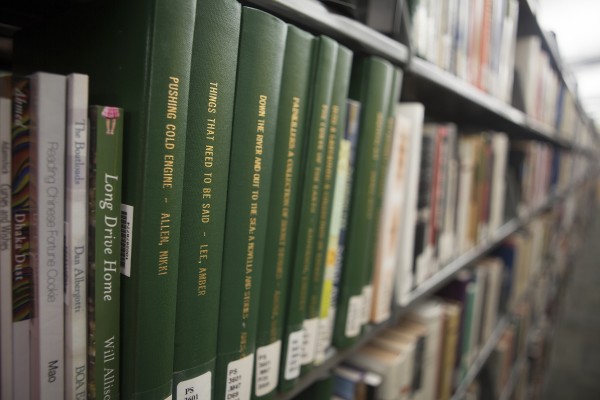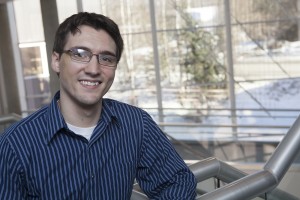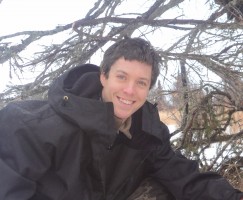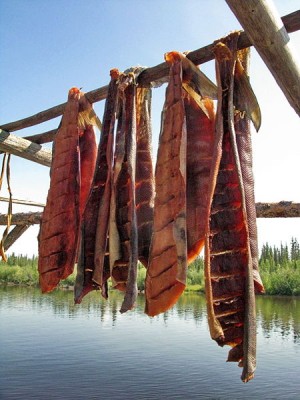Homeless youth in Fairbanks, snow disposal in Fairview and Chinook management in Western Alaska—it’s thesis season
by Jamie Gonzales |

Looking for a good read? Pick up a UAA student thesis at the Consortium Library. Philip Hall/University of Alaska Anchorage.
Intermingled in the stacks at the UAA/APU Consortium Library, you'll find hardbound evidence of UAA student scholarship. One- and two-inch-thick thesis volumes explore everything from biological sciences to creative writing.
Graduate students like Kevin Bartley (anthropology) and Sherry Wolf (nursing), as well as undergraduate students like Nathaniel Cox (engineering), are feverishly working to net all of their glimmering, wriggly, newly acquired knowledge into a cohesive thesis or capstone presentation in time for spring graduation. Their final projects-whether it's a thesis volume to add to the stacks or a multimedia presentation-demonstrate to their professors and peers just how deftly they've applied all they learned in the classroom and in textbooks during their years at UAA.
How do homeless youth in Fairbanks care for their health?
An experienced public health and school nurse, nursing graduate student Sherry Wolf has crossed paths with homeless youth in Fairbanks for years-there is, she said, a significant homeless youth population in the city at any given time during the year. Her ultimate goal in returning to UAA to become a family nurse practitioner? To better serve the homeless community in Fairbanks.
Almost two years ago she began her thesis research, investigating how homeless youth in Fairbanks take care of their health.
"We all think of the homeless as those people who stay in the wooded areas, but that's not the case," she said. "You've probably met homeless youth in coffee shops and on campus. Some couch surf, some stay in empty buildings if they think they won't be caught, some stay in cars."
What she wanted to gather was their honest responses to her qualitative study questions about how they take care of their health. The results, she said, weren't necessarily what she anticipated.
The respondents in her study, aged 18-25, didn't tick off doctor appointments or traditional health care regimens. For them, caring for their health meant finding shelter, food and water.
"Surprisingly they also talked about building a better future," Wolf said. "Three of them are in college. They all have goals, too. That's part of taking care of themselves."
On April 8, Wolf will defend her thesis via video conference from Fairbanks with her Anchorage-based thesis committee.
Drain, drain, go away-getting rid of the snow mountains in Fairview
Senior Nathaniel Cox had another community's puzzle to solve. What if, in some of Anchorage's densely-designed neighborhoods, we could find a more elegant way to deal with the snow plowed from road and sidewalk surfaces rather than trucking it away? Cox is working with a small team in his engineering capstone course to test the feasibility of melting and infiltrating it for local disposal, no trucks required.
Cox's capstone course places students in a simulated professional environment where they interview for positions and project teams. All of the projects have the potential for real-life benefit to an Alaska community.
"The civil engineering department rarely searches for where students can provide solutions to engineering problems," Cox said. "Instead community partners often ask for assistance with the projects."
The design project, where Cox serves as leader of the structural design team, was developed in response to a query from the Fairview Community Council. Could UAA help them dig out from under their snow problem?
The team's design study report and final presentation has drawn on their years of classroom study to stitch together.
"Engineering students are not necessarily trained to memorize every detail about the broad variety of subjects which we are taught, but instead how to critically analyze the system provided," he said. "One professor has always stated, 'It is not about what you know, but that you know where to find it.'"
He's excited to see the team's hard work pay off for the community. "If the design is shown to be feasible for the requirements provided, it is very possible that the facility will be constructed," he said.
Cox, who was born and raised in Anchorage, is committed to solving Alaska's future engineering quandaries, too.
"Alaska will always be my home," he said. "I will be working on a research project over the summer of 2014 funded by the Alaska Space Grant Foundation." Afterward, he'll go to work for a local engineering firm until he starts an engineering master's program in fall of 2015.
Can it be done? Collaborative fish and game management between Alaska Native communities and federal resource managers
Anthropology graduate student Kevin Bartley is a Kentucky native, but he considers Alaska his adopted home. An archaeological study in Portugal seven years ago helped nudge him toward a degree in anthropology.
"I told myself I had to find out how to get paid to go to places I couldn't afford to go," he said with a laugh. His graduate research, though, has serious implications for ways in which Alaska Natives and federal fisheries managers can best collaborate to manage a precious resource-Chinook salmon.
When he arrived in Alaska in 2007, he started taking classes with Professor Steve Langdon and began gravitating toward Alaska Native policy. An undergraduate degree in anthropology led to graduate study in his field and research into collaborative management of fish and game resources in Western Alaska.
For the last two years, he's explored Alaska Natives involvement, or lack of involvement, in federal management of Chinook salmon in the Kuskokwim Management Area.
On March 21, he defended his thesis before a committee and is hard at work making final adjustments before graduation.
For his thesis research, he interviewed people from nine villages along the Kuskokwim River about Chinook resource management.
"The people of the river would like to be more involved in the decision-making," Bartley said. "Subsistence restrictions have been getting heavier, with closures during optimal [fish] drying times in Western Alaska...This year, agency managers have reported that there will be zero Chinook salmon available for subsistence harvest on the Yukon and Kuskokwim Rivers."
The research that took him to Western Alaska for three months was funded in part by a grant from the Department of the Interior Office of Subsistence Management. Federal fisheries managers, Bartley said, to their credit, are interested in learning a better way forward.
"This may be the first project of its kind funded from a social science perspective," he said. "Most subsistence related studies inquire about the number of fish and wildlife harvested by rural residents in Alaska. Not so many gather input on how to make policies better."
He's come to believe people need the opportunity to practice their culture. What he heard from the people in villages along the Kuskokwim was that they don't want to forget how to fish. They want to teach their children how to fish.
"What happens to future generations of rural residents in Alaska when they are afforded fewer and fewer opportunities to learn how to fish?" said Bartley.
The chief barrier to collaborative management, he said, was lack of interaction between subsistence fishermen and federal managers.
The good news?
"It's also the number one most fixable problem," he said. It just requires some investment from government entities like the Department of the Interior.
Following graduation, Bartley is researching his options as an anthropologist here in Alaska.
He echoed his Class of 2014 peers Cox and Wolf when he said, "Alaska is home. This is the place that makes me happy."
Written by Jamie Gonzales, UAA Office of University Advancement.
 "Homeless youth in Fairbanks, snow disposal in Fairview and Chinook management in Western
Alaska—it’s thesis season" is licensed under a Creative Commons Attribution-NonCommercial 4.0 International License.
"Homeless youth in Fairbanks, snow disposal in Fairview and Chinook management in Western
Alaska—it’s thesis season" is licensed under a Creative Commons Attribution-NonCommercial 4.0 International License.

















